Granular Calcite: A New Cultural Practice to Improve the Physicochemistry of the Peat Substrate, Growth and Morphophysiological Quality of White Spruce Seedlings in Forest Nurseries
Abstract
:1. Introduction
2. Materials and Methods
2.1. Plant Material, Covering Material and Experimental Design
2.2. Assessment of Environmental Variables
2.3. White Spruce Seedling Production
2.4. Assessment of Variations in the pH Gradient and the Fertility of the Substrate Depending on the Cover Material and the Height Level of the Root-Plug
2.5. Fertility and Physicochemical Properties of the Substrate, Growth and Mineral Nutrition of White Spruce Seedlings (1 + 0)
2.6. Statistical Analyses and Modelling of Growth Variables
2.6.1. Analysis of Variance
2.6.2. Modeling of Growth Variables and Dry Matter Allocation
3. Results
3.1. Environmental Variables, Irrigation and Substrate Water Content
3.2. Assessment of Variations in the pH Gradient and Substrate Fertility Depending on the Cover Material and the Level of the Substrate-Plug Height during the Germination Phase
3.3. Fertility and Physicochemical Characteristics of the Substrate during the First Growing Season of White Spruce Seedlings (1 + 0)
3.4. Growth of White Spruce Seedlings (1 + 0)
3.5. Determination of Logistic Growth Models According to the Covering Material
3.6. Dry Matter Allocation Models between the Shoots and the Roots According to the Covering Material
3.7. Mineral Nutrition
4. Discussion
5. Conclusions and Practical Recommendations
Supplementary Materials
Author Contributions
Funding
Institutional Review Board Statement
Informed Consent Statement
Acknowledgments
Conflicts of Interest
References
- Lamhamedi, M.S.; Lambany, G.; Margolis, H.A.; Renaud, M.; Veilleux, L.; Bernier, P.Y. Growth, physiology and leachate losses in Picea glauca seedlings (1+0) grown in air-slit containers under different irrigation regimes. Can. J. For. Res. 2001, 31, 1968–1980. [Google Scholar] [CrossRef] [Green Version]
- Lamhamedi, M.S.; Labbé, L.; Margolis, H.A.; Stowe, D.C.; Blais, L.; Renaud, M. Spatial variability of substrate water content and growth of white spruce seedlings. Soil Sci. Soc. Am. J. 2006, 70, 108–120. [Google Scholar] [CrossRef] [Green Version]
- Stowe, D.C.; Lamhamedi, M.S.; Margolis, H.A. Water relations, cuticular transpiration, and bud characteristics of air-slit containerized Picea glauca seedlings in response to controlled irrigation regime. Can. J. For. Res. 2001, 31, 1922–1929. [Google Scholar] [CrossRef]
- Stowe, D.C.; Lamhamedi, M.S.; Carles, S.; Fecteau, B.; Margolis, H.A.; Renaud, M.; Bernier, P. Managing irrigation to reduce nutrient leaching in containerized white spruce seedling production. New For. 2010, 40, 185–204. [Google Scholar] [CrossRef]
- Lamhamedi, M.S.; Chamberland, H.; Bernier, P.Y.; Tremblay, F.M. Clonal variation in morphology, growth, physiology, anatomy and ultrastructure of container-grown white spruce somatic seedlings. Tree Physiol. 2000, 20, 869–880. [Google Scholar] [CrossRef] [PubMed] [Green Version]
- Wahid, N.; Lamhamedi, M.S.; Rainville, A.; Beaulieu, J.; Margolis, H.A. Genetic control and nursery-plantation genotypic correlations for growth characteristics of white spruce somatic clones. J. Sustain. For. 2013, 32, 576–593. [Google Scholar] [CrossRef]
- Wahid, N.; Lamhamedi, M.S.; Beaulieu, J.; Margolis, H.; Deblois, J. Genetic parameters and clonal variation in growth and nutritional traits in containerized white spruce somatic seedlings. Bot. Gallica 2012, 159, 373–384. [Google Scholar] [CrossRef]
- Lamhamedi, M.S. Variabilité spatiale et variations extrêmes des teneurs en eau du substrat en pépinière forestière: Facteurs aggravants de l’insuffisance racinaire. Ministère des Ressources naturelles et de la Faune, Direction de la recherche forestière. Avis De Rech. For. 2011, 28, 1–2. [Google Scholar]
- MFFP. Guide de Terrain. Inventaire de Qualification des Plants Résineux Cultivés en Récipients; Gouvernement du Québec: Québec, QC, Canada, 2019; p. 114.
- Lamhamedi, M.S. 2013. Principaux facteurs et techniques culturales affectant la germination des semences et la croissance des plants en pépinière forestière. In Atelier sur les Semences Forestières: Un Maillon Clé des Plantations de Grande Valeur; Gouvernement du Québec, Ministère des Ressources naturelles du Québec: Québec, QC, Canada, 2013; pp. 22–25. [Google Scholar]
- Lamhamedi, M.S. Variabilité de la Qualité de la Silice et Comparaison des Effets de la Silice et de la Calcite sur la Croissance et la Nutrition Minérale des Plants en Pépinière Forestière. Journée de Transfert de Connaissances; Office des Producteurs de Plants Forestiers du Québec: Québec, QC, Canada, 2015; p. 66.
- Lamhamedi, M.S.; Bernier, P.Y.; Hébert, C.; Jobidon, R. Physiological and growth responses of three types of containerized Picea mariana seedlings outplanted with and without vegetation control. For. Ecol. Manag. 1998, 110, 13–23. [Google Scholar] [CrossRef]
- Lamhamedi, M.S.; Bernier, P.Y.; Hébert, C. Effect of shoot size on the gas exchange and growth of containerized Picea mariana seedlings under different watering regimes. New Forests 1997, 13, 209–223. [Google Scholar] [CrossRef]
- Caron, J. La tourbe et les milieux artificiels. In Écologie des Tourbières du Québec-Labrador; Payette, S., Rochefort, L., Eds.; Presses de l’Université Laval: Québec, QC, Canada, 2001; pp. 399–410. [Google Scholar]
- Lamhamedi, M.S.; Renaud, M.; Veilleux, L. Les effets de l’augmentation du pH des substrats sur la croissance des plants forestiers produits dans les pépinières forestières? In Production de Plants Forestiers au Québec: La Culture de L’innovation, Proceedings of the Colloque de Transfert de Connaissances et de Savoir-Faire, Carrefour Forêt Innovations, Québec, QC, Canada, 4–6 October 2011; Colas, F., Lamhamedi, M.S., Eds.; Gouvernement du Québec: Québec, QC, Canada, 2011; pp. 33–45. [Google Scholar]
- Rikala, R.; Jozefek, H.J. Effect of dolomite lime and wood ash on peat substrate and development of tree seedlings. Silva Fenn. 1990, 24, 323–334. [Google Scholar] [CrossRef] [Green Version]
- Rippy, J.F.M. Factors Affecting pH Establishment and Maintenance in Peat Moss-Based Substrates. Ph.D. Thesis, North Carolina State University, Raleigh, NC, USA, 2005. [Google Scholar]
- South, D.B. Optimum pH for growing pine seedlings. Tree Plant. Notes 2017, 60, 49–62. [Google Scholar]
- South, D.B.; Nadel, R.L.; Enebak, S.A.; Bickerstaff, G. Sulfur and lime affect soil pH and nutrients in a sandy Pinus taeda nursery. Reforesta 2017, 4, 12–20. [Google Scholar] [CrossRef]
- Lamhamedi, M.S.; Renaud, M.; Auger, I.; Fortin, J.A. Granular calcite stimulates natural mycorrhization and growth of white spruce seedlings in peat-based substrates in forest nursery. Microorganisms 2020, 8, 1088. [Google Scholar] [CrossRef]
- Lamhamedi, M.S.; Renaud, M.; Auger, I. Stimulation par la calcite de la colonisation ectomycorhizienne des racines des plants d’épinette blanche (2+0) et augmentation de leur croissance dans les substrats tourbeux en pépinière forestière. Gouvernement du Québec, ministère des Forêts, de la Faune et des Parcs. Mémoire De Rech. For. 2020, 182, 50. [Google Scholar]
- Lamhamedi, M.S.; Renaud, M.; Desjardins, P.; Veilleux, L. Root growth, plug cohesion, mineral nutrition, and carbohydrate content of (1+0) Picea mariana seedlings in response to a short-day treatment. Tree Plant. Notes 2013, 56, 35–46. [Google Scholar]
- Girard, D.; Gagnon, J.; Langlois, C.-G. PLANTEC: Un logiciel pour gérer la fertilisation des plants dans les pépinières forestières. Gouvernement du Québec, ministère des Ressources naturelles, Direction de la recherche forestière. Note De Rech. For. 2001, 111, 1–8. [Google Scholar]
- Kalra, Y.P.; Maynard, D.G. Méthodes D’analyses des Sols Forestiers et des Tissus Végétaux; Rapport d’information NOR-X-319F; Forêts Canada, Région du Nord-Ouest, Centre de foresterie du Nord: Edmonton, AB, Canada, 1992; p. 129. [Google Scholar]
- Gagnon, J.; DeBlois, J. Effects of foliar urea fertilization on nitrogen concentrations of containerized 2 + 0 jack pine seedlings produced in forest nurseries. Tree Plant. Notes 2017, 60, 44–50. [Google Scholar]
- Timmer, V.R.; Armstrong, G.; Miller, B.D. Steady-state nutrient preconditioning and early outplanting performance of containerized black spruce seedlings. Can. J. For. Res. 1991, 21, 585–594. [Google Scholar] [CrossRef]
- Ågren, G.I. Theory for growth of plants derived from the nitrogen productivity concept. Physiol. Plant. 1985, 64, 17–28. [Google Scholar] [CrossRef]
- Ledig, F.T.; Bormann, F.H.; Wenger, K.F. The distribution of dry matter growth between shoot and roots in loblolly pine. Bot. Gaz. 1970, 131, 349–359. [Google Scholar] [CrossRef]
- Qualtiere, E.J. Variation in Germination Response to Temperature among Collections of Three Conifers from the Mixed Wood Forest. Ph.D. Thesis, University of Saskatchewan, Saskatoon, SK, Canada, 2008. [Google Scholar]
- Timmer, V.R.; Parton, G. Monitoring nutrient status of containerized seedlings. In Proceedings of the Ontario Ministry of Natural Ressources Nurseryman’s Meeting, Thunder Bay, ON, Canada, 7–11 June 1982; pp. 48–58. [Google Scholar]
- White, P.J.; Broadley, M.R. Calcium in plants. Ann. Bot. 2003, 92, 487–511. [Google Scholar] [CrossRef]
- Hochmal, A.K.; Shulze, S.; Trompelt, K.; Hippler, M. Calcium-dependent regulation of photosynthesis. Biochim. Biophys. Acta 2015, 1847, 993–1003. [Google Scholar] [CrossRef] [PubMed] [Green Version]
- Desilva, D.L.R.; Hetherington, A.M.; Mansfield, T.A. Synergism between calcium and abscisic acid in preventing stomatal opening. New Phytol. 1985, 100, 437–482. [Google Scholar]
- Feagley, S.E.; Fenn, L.B. Using Soluble Calcium to Stimulate Plant Growth; Texas Agricultural Extension service; The Texas A&M University System: College Station, TX, USA, 1998; 4p. [Google Scholar]
- Yang, B.Z.; Liu, Z.B.; Zhou, S.D.; Ou, L.J.; Dai, X.Z.; Ma, Y.Q.; Zhang, Z.Q.; Chen, W.C.; Li, X.F.; Liang, C.L.; et al. Exogenous Ca2+ alleviates waterlogging-caused damages to pepper. Photosynthetica 2016, 54, 620–629. [Google Scholar] [CrossRef]
- Gagnon, J.; Lamhamedi, M.S. Les concentrations foliaires en azote recommandées au Québec pour les essences résineuses produites en récipients sont-elles adéquates. In Production de Plants Forestiers au Québec: La Culture de L’innovation, Proceedings of the Colloque de Transfert de Connaissances et de Savoir-Faire, Carrefour Forêt Innovations, Québec, QC, Canada, 4–6 October 2011; Colas, F., Lamhamedi, M.S., Eds.; Gouvernement du Québec: Québec, QC, Canada, 2011; pp. 47–51. [Google Scholar]
- Lopez-Lefebre, L.R.; Rivero, R.M.; García, P.C.; Sanchez, E.; Ruiz, J.M.; Romero, L. Effect of calcium on mineral nutrient uptake and growth of tobacco. J. Sci. Food Agric. 2001, 81, 1334–1338. [Google Scholar] [CrossRef]
- Zhao, H.J.; Tan, J.-F. Role of calcium ion in protection against heat and high irradiance stress-induced oxidative damage to photosynthesis of wheat leaves. Photosynthetica 2005, 43, 473–476. [Google Scholar] [CrossRef]
- Halman, J.M.; Schaberg, P.G.; Hawley, G.J.; Eagar, C. Calcium addition at the Hubbard Brook Experimental Forest increases sugar storage, antioxidant activity and cold tolerance in native spruce (Picea rubens). Tree Physiol. 2008, 28, 855–862. [Google Scholar] [CrossRef] [Green Version]
- Palta, J.P. Role of calcium in plant responses to stresses: Linking basic research to the solution of practical problems. HortScience 1996, 31, 51–57. [Google Scholar] [CrossRef] [Green Version]
- Percival, G.; Barnes, S. Calcium-induced freezing and salinity tolerance in evergreen oak and apple cv. Golden Crown. Arbor. Urban For. 2008, 34, 191–199. [Google Scholar]
- Lamhamedi, M.S. Principaux facteurs influençant le développement racinaire et effets de l’irrigation sur la croissance et la physiologie des racines en pépinière forestière. In Recueil des Conférences et des Résumés du 4e Atelier sur la Production de Plants Forestiers du Québec; Gouvernement du Québec, Ministère des Ressources Naturelles et de la Faune [cd-rom]: Sainte-Foy, QC, Canada, 2006; p. 2. [Google Scholar]
- Lamhamedi, M.S. Lamhamedi, M.S. La masse des racines pourrait-elle être utilisée comme un critère de qualité avant la livraison des plants en site de reboisement? In Production de Plants Forestiers au Québec: La Culture de L’innovation, Proceedings of the Colloque de Transfert de Connaissances et de Savoir-Faire, Carrefour Forêt Innovations, Québec, QC, Canada, 4–6 October 2011; Colas, F., Lamhamedi, M.S., Eds.; Gouvernement du Québec: Québec, QC, Canada, 2011; pp. 65–69. [Google Scholar]
- Lamhamedi, M.S.; Renaud, M.; Desjardins, P.; Veilleux, L. Évaluation de la qualité morpho-physiologique du système racinaire des plants du mélèze laricin: Les racines foncées ou noires peuvent-elles être considérées mortes? Gouvernement du Québec, ministère des Ressources naturelles et de la Faune du Québec, Direction de la recherche forestière. Avis Tech. SGRE 2011, 3, 1–33. [Google Scholar]
- Gagnon, J.; Lamhamedi, M.S. L’inoculation des plants résineux en récipients par des spores de champignons ectomycorhiziens à l’automne pourrait-elle contribuer à réduire les problèmes d’insuffisance racinaire dans les pépinières forestières du Québec? In Production de Plants Forestiers au Québec: La Culture de L’innovation, Proceedings of the Colloque de Transfert de Connaissances et de Savoir-Faire, Carrefour Forêt Innovations, Québec, QC, Canada, 4–6 October 2011; Colas, F., Lamhamedi, M.S., Eds.; Gouvernement du Québec: Québec, QC, Canada, 2011; pp. 27–32. [Google Scholar]
- Rillig, M.C.; Mummy, D.L. Mycorrhizas and soil structure. New Phytol. 2006, 171, 4–53. [Google Scholar] [CrossRef]
- Read, D.J. The mycorrhizal mycelium. In Mycorrhizal Functioning: An Integrative Plant-Fungal Process; Allen, M., Ed.; Chapman and Hell: New York, NY, USA, 1992; pp. 102–133. [Google Scholar]
- Kropp, B.R.; Langlois, C.-G. Ectomycorrhizae in reforestation. Can. J. For. Res. 1990, 20, 438–451. [Google Scholar] [CrossRef]
- Lamhamedi, M.S.; Abourouh, M.; Fortin, J.A. Technological transfer: The use of ectomycorrhizal fungi in conventional and modern forest tree nurseries in northern Africa. In Advances in Mycorrhizal Science and Technology; Khasa, D., Piché, Y., Coughlan, A.P., Eds.; NRC Research Press: Ottawa, ON, Canada, 2009; pp. 139–152. [Google Scholar]
- Marx, D.H.; Cordell, C.E. The use of specific ectomycorrhizas to improve artificial forestation practices. In Biotechnology of Fungi for Improving Plant Growth; Whipps, J.M., Lumsden, R.D., Eds.; Cambridge University Press: Cambridge, UK, 1989; pp. 1–25. [Google Scholar]
- Perry, D.A.; Molina, R.; Amaranthus, M.P. Mycorrhizae, mycorrhizospheres, and reforestation: Current knowledge and research needs. Can. J. For. Res. 1987, 17, 929–940. [Google Scholar] [CrossRef]
- Marx, D.H. Ectomycorrhizae as bilogical deterrents to pathogenic root infections. Annu. Rev. Phytopathol. 1972, 10, 429–454. [Google Scholar] [CrossRef]
- Zak, B. Role of mycorrhizae in root disease. Annu. Rev. Phytopathol. 1964, 2, 377–392. [Google Scholar] [CrossRef]
- Whipps, J.M. Prospects and limitations for mycorrhizas in biocontrol of root pathogens. Can. J. Bot. 2004, 82, 1198–1227. [Google Scholar] [CrossRef]
- Otgonsuren, B.; Lee, M.J. Ectomycorrhiza enhanced the cold-acclimation growth and freeze tolerance of Scots pine (Pinus sylvestris L.). Taiwan, J. For. Sci. 2013, 28, 97–111. [Google Scholar]
- Lamhamedi, M.S.; Fortin, J.A.; Bernier, P.Y. La génétique de Pisolithus sp.: Une nouvelle approche de biotechnologie forestière pour assurer une meilleure survie des plants en conditions de sécheresse. Sécheresse 1991, 2, 251–258. [Google Scholar]
- Lamhamedi, M.S.; Bernier, P.Y.; Fortin, J.A. Hydraulic conductance and soil water potential at the soil-root interface of Pinus pinaster seedlings inoculated with different dikaryons of Pisolithus sp. Tree Physiol. 1992, 10, 231–244. [Google Scholar] [CrossRef]
- Lehto, T.; Zwiazek, J.J. Ectomycorrhizas and water relations of trees: A review. Mycorrhiza 2011, 21, 71–90. [Google Scholar] [CrossRef] [PubMed]
- Read, D.J.; Boyd, R. Water relations of mycorrhizal fungi and their host plants. In Water, Fungi and Plants; Ayres, P.G., Body, L., Eds.; Cambridge University Press: Cambridge, UK, 1986; pp. 287–304. [Google Scholar]
- Landis, T.D.; Tinus, R.W.; McDonald, S.E.; Barnett, J.P. The Container Tree Nursery Manual. Vol. 4: Seedling Nutrition and Irrigation. In Handbook Agric. n 674, U.S.D.A.; Forest Service: Washington, DC, USA, 1989; 119p. [Google Scholar]
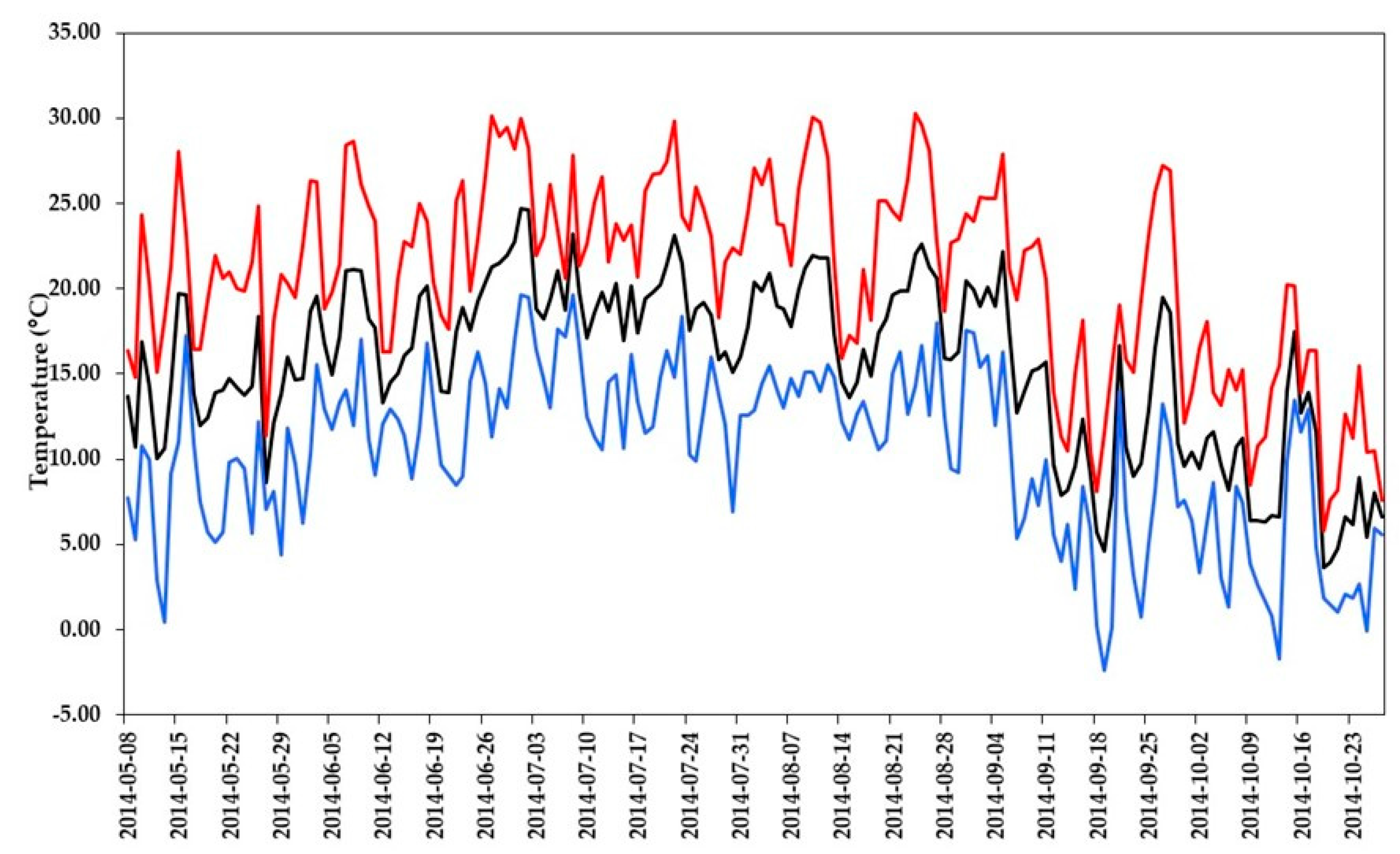
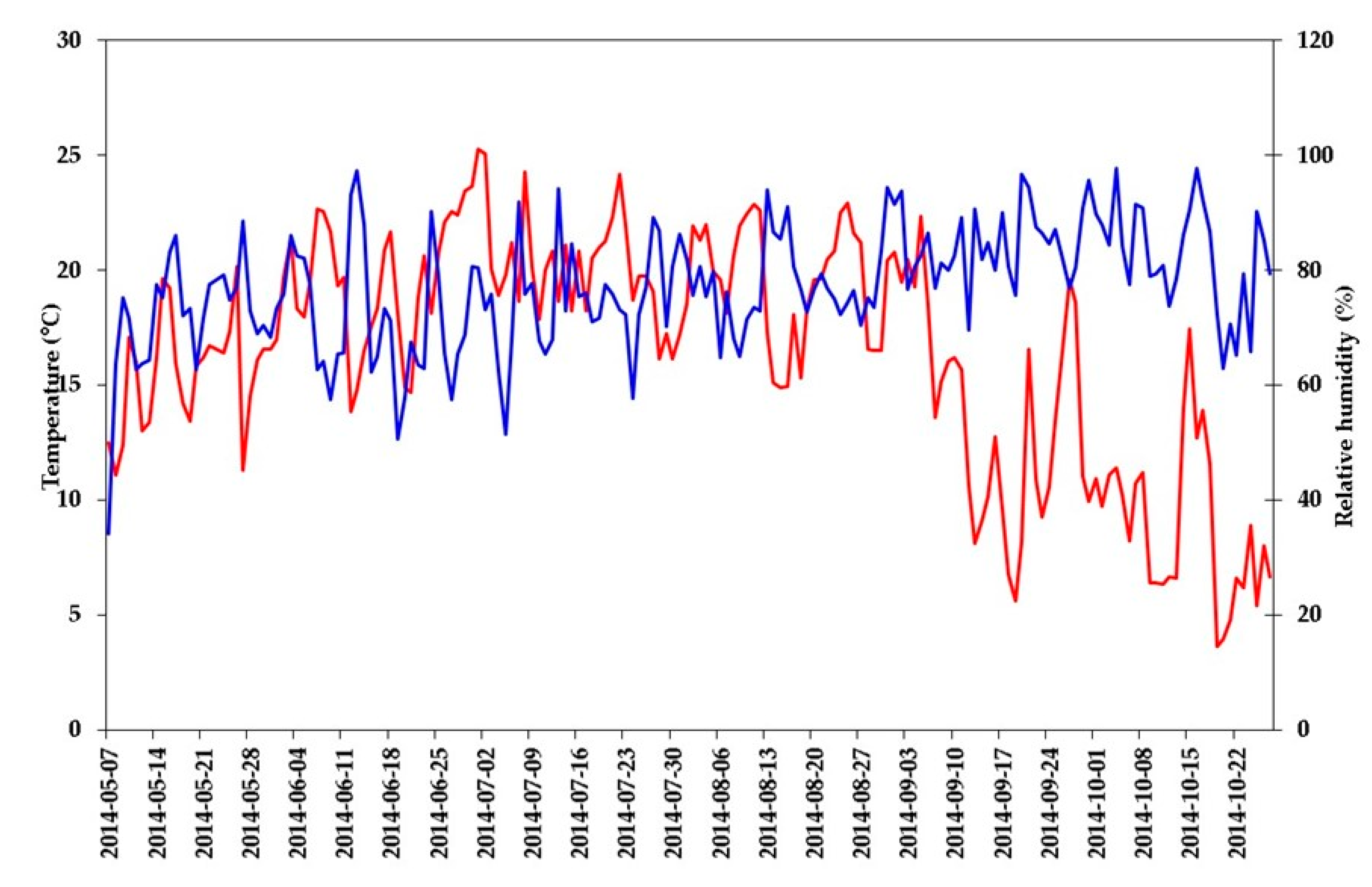
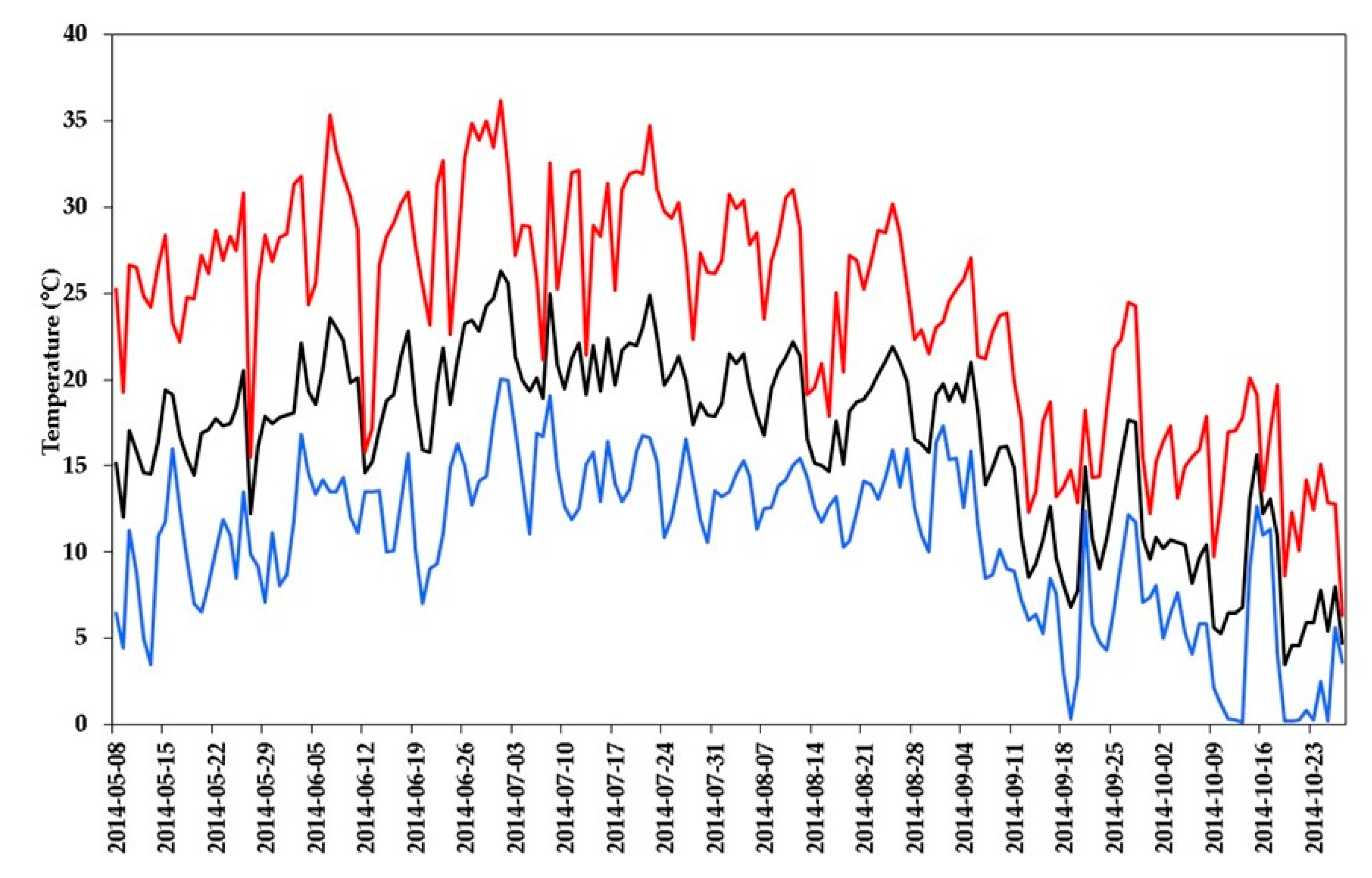
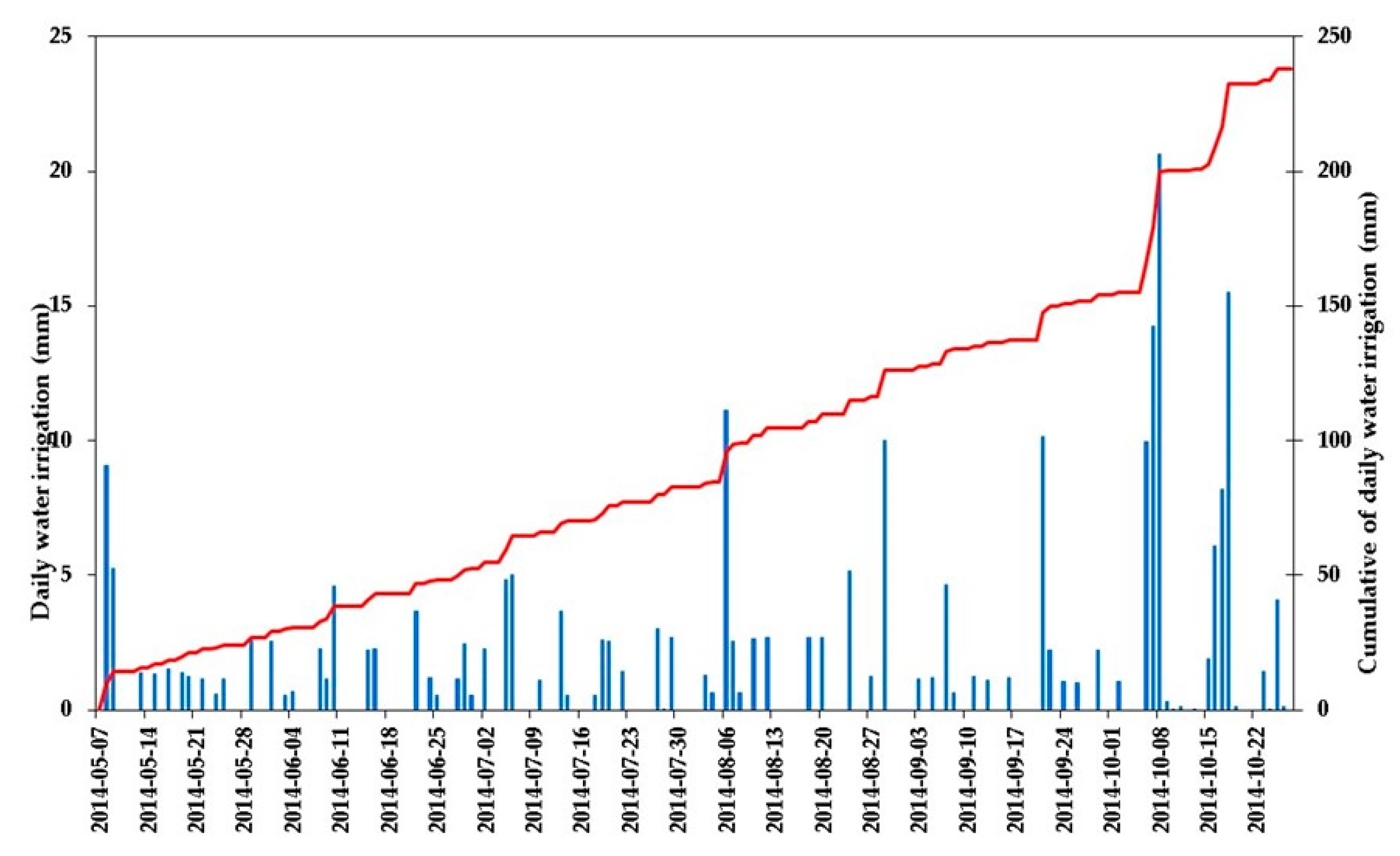
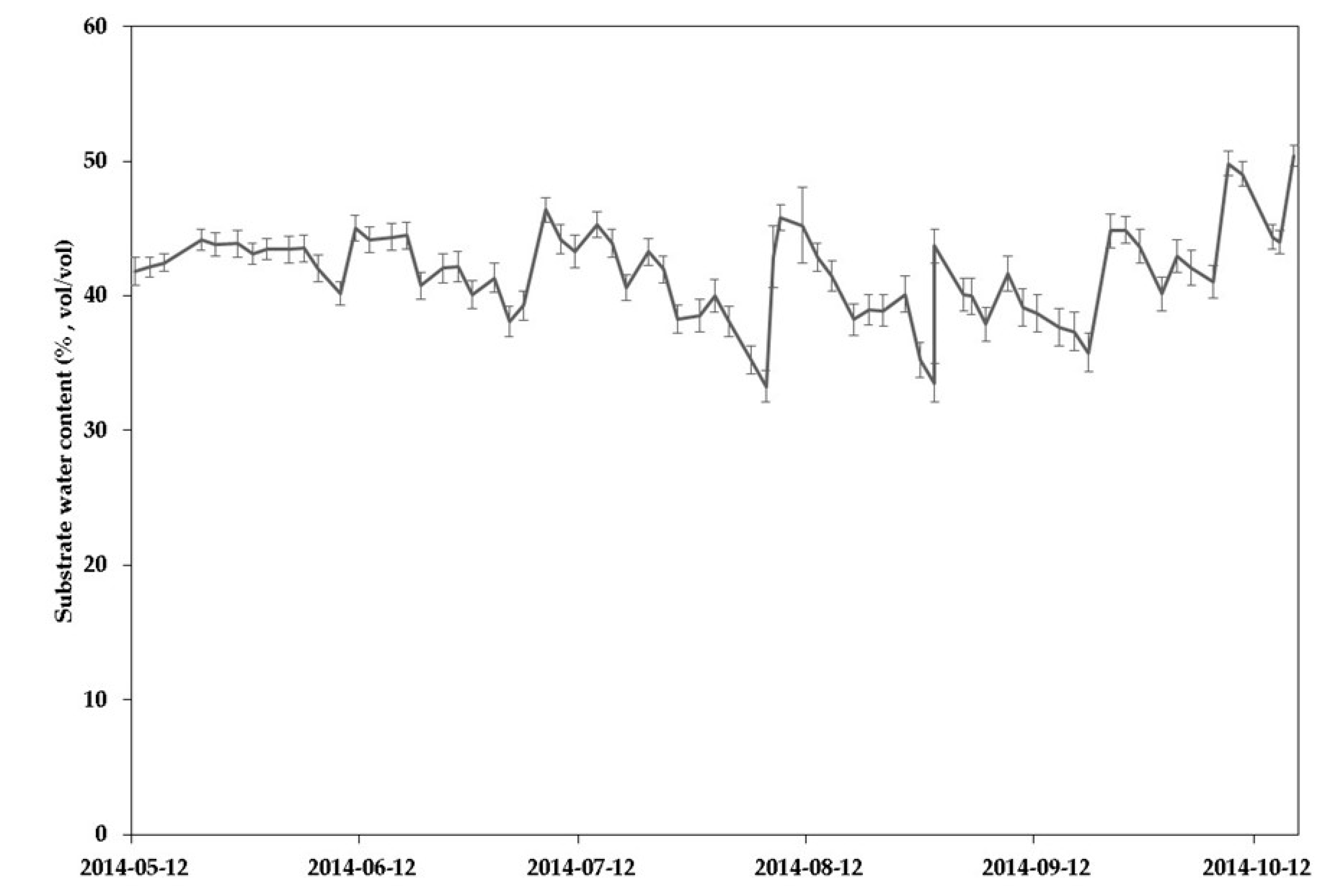
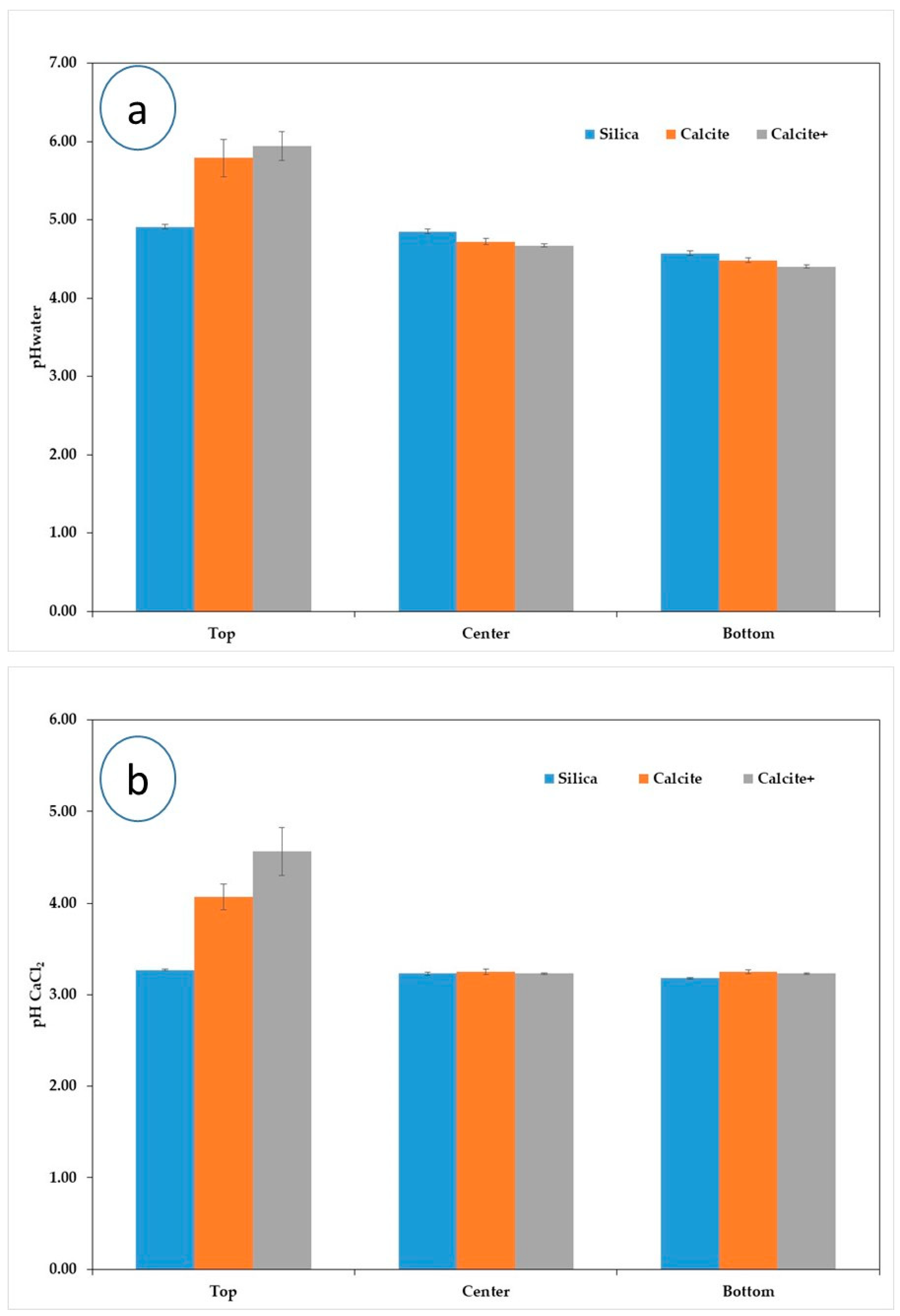


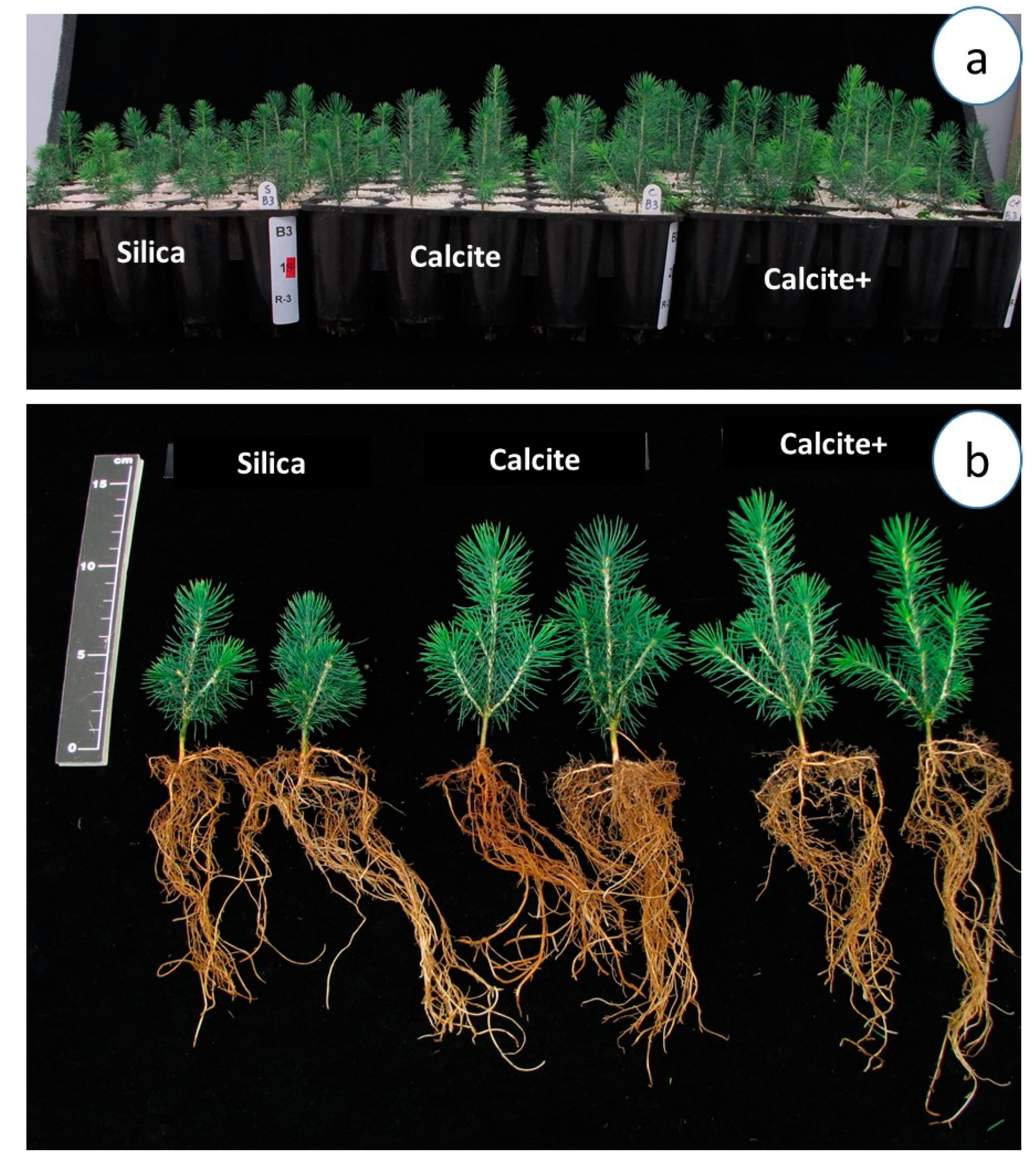
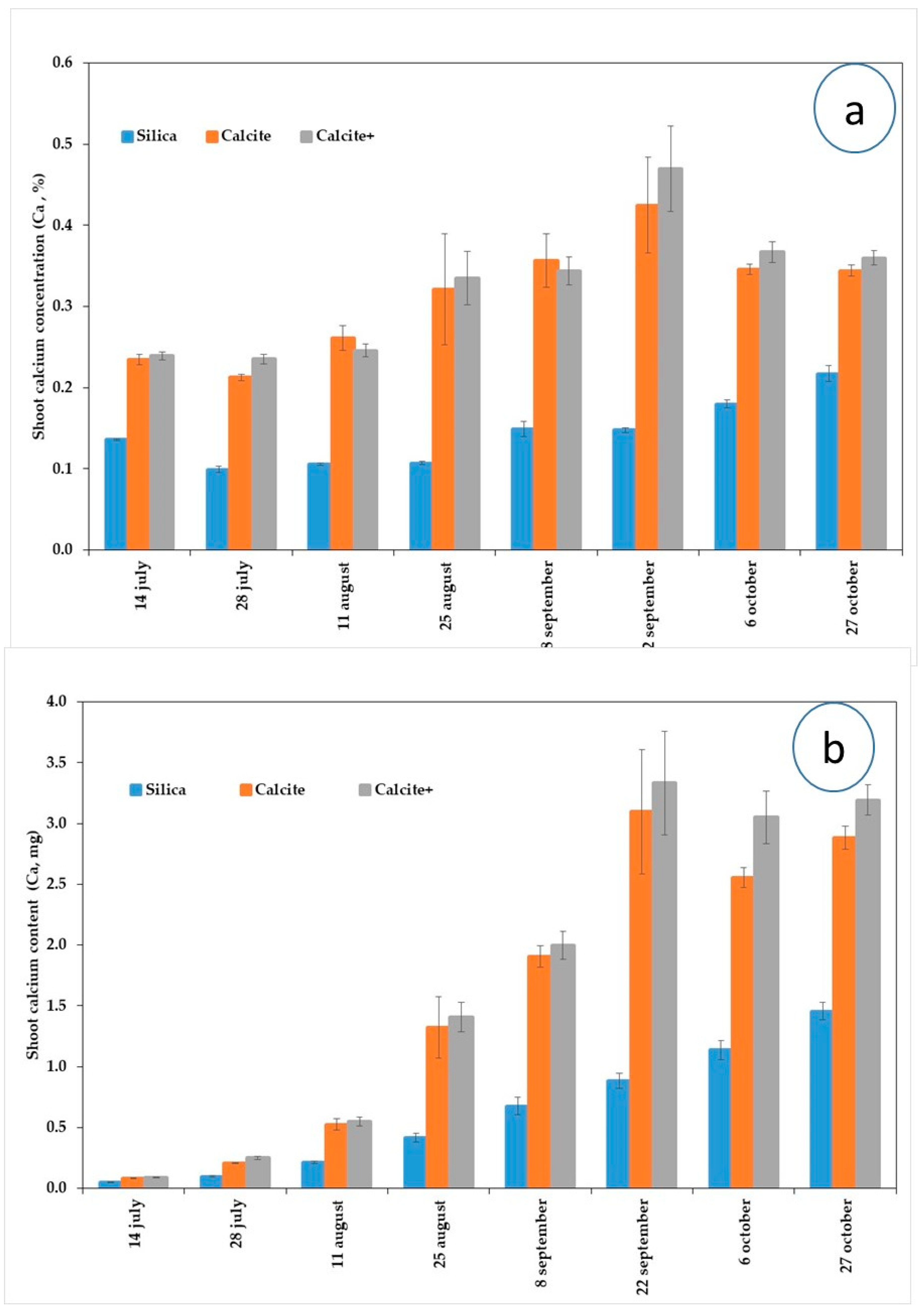

| Source of Variation | dln * | dld * | pHwater | pHCaCl2 | N-NH4 (mg/kg) | N-NO3 (mg/kg) | Nmin (mg/kg) | P (mg/kg) | K (mg/kg) | Ca (mg/kg) | Mg (mg/kg) |
|---|---|---|---|---|---|---|---|---|---|---|---|
| Treatment | 2 | 28.2 | 0.0536 | <0.0001 | 0.0152 | 0.0021 | <0.0001 | <0.0001 | <0.0001 | <0.0001 | <0.0001 |
| Calcite/Calcite+ vs. Silica | (1) | 28.2 | 0.0165 | <0.0001 | 0.0134 | 0.0005 | <0.0001 | <0.0001 | <0.0001 | <0.0001 | <0.0001 |
| Calcite vs. Calcite+ | (1) | 28.2 | 0.9651 | 0.0436 | 0.0794 | 0.8400 | 0.5194 | 0.0052 | 0.0345 | 0.8246 | 0.9246 |
| Date | 1 | 27.4 | <0.0001 | 0.1326 | <0.0001 | 0.0224 | 0.0004 | <0.0001 | <0.0001 | 0.0017 | 0.2380 |
| Date × Treatment | 2 | 27.4 | 0.0117 | 0.0020 | 0.1534 | 0.0401 | 0.0351 | <0.0001 | 0.1652 | 0.0104 | 0.0238 |
| Level | 2 | 29.2 | <0.0001 | <0.0001 | <0.0001 | <0.0001 | <0.0001 | <0.0001 | <0.0001 | <0.0001 | <0.0001 |
| Level × Treatment | 4 | 29.2 | <0.0001 | <0.0001 | 0.0233 | 0.0072 | 0.0134 | <0.0001 | 0.0091 | 0.0005 | 0.0004 |
| Date × Level | 2 | 29.2 | <0.0001 | <0.0001 | 0.1985 | <0.0001 | 0.0003 | <0.0001 | 0.0036 | 0.0003 | 0.0034 |
| Date × Level × Treatment | 4 | 29.2 | 0.0064 | 0.0099 | 0.4317 | 0.0106 | 0.0040 | <0.0001 | 0.0843 | 0.0213 | 0.0182 |
| Source of Variation | dln * | dld * | pH Water | pH CaCl2 | Cond (µS/cm) | N-NH4 (mg/kg) | N-NO3 (mg/kg) | Nmin (mg/kg) | P (mg/kg) | K (mg/kg) | Ca (mg/kg) | Mg (mg/kg) |
|---|---|---|---|---|---|---|---|---|---|---|---|---|
| Treatement | 2 | 17.0 | 0.0004 | 0.0001 | 0.0001 | <0.0001 | 0.0025 | 0.0119 | <0.0001 | 0.0025 | <0.0001 | <0.0001 |
| Calcite/Calcite+ vs. Silica | (1) | 17.0 | 0.0002 | <0.0001 | 0.8206 | <0.0001 | 0.0079 | 0.0873 | <0.0001 | 0.0020 | <0.0001 | <0.0001 |
| Calcite vs. Calcite+ | (1) | 17.0 | 0.0669 | 0.2322 | <0.0001 | 0.0563 | 0.0132 | 0.0112 | 0.4625 | 0.0767 | 0.0219 | 0.0028 |
| Date | 7 | 16.0 | <0.0001 | <0.0001 | <0.0001 | <0.0001 | <0.0001 | <0.0001 | <0.0001 | <0.0001 | <0.0001 | <0.0001 |
| Date (linear effect) | (1) | 14.6 | <0.0001 | <0.0001 | <0.0001 | <0.0001 | <0.0001 | <0.0001 | <0.0001 | <0.0001 | <0.0001 | <0.0001 |
| Date (quadratic effect) | (1) | 16.2 | <0.0001 | 0.5654 | <0.0001 | 0.0003 | <0.0001 | <0.0001 | <0.0001 | <0.0001 | <0.0001 | <0.0001 |
| Date × Treatment | 14 | 16.0 | 0.1496 | 0.0262 | 0.0001 | <0.0001 | 0.0016 | 0.0053 | <0.0001 | 0.0013 | <0.0001 | 0.0047 |
| Source of Variation | dln * | dld * | Height (H) (cm) | Diameter (D) (mm) | H/D | Shoot Dry Mass (mg) | Root Dry Mass (mg) | Total Dry Mass (g) |
|---|---|---|---|---|---|---|---|---|
| Treatment | 2 | 26.0 | <0.0001 | <0.0001 | <0.0001 | 0.0001 | <0.0001 | <0.0001 |
| Calcite/calcite+ vs. Silica | (1) | 26.0 | <0.0001 | <0.0001 | <0.0001 | <0.0001 | <0.0001 | <0.0001 |
| Calcite vs. Calcite+ | (1) | 26.0 | 0.0232 | 0.0302 | 0.2198 | 0.0993 | 0.0628 | 0.0819 |
| Date | 7 | 22.5 | <0.0001 | <0.0001 | <0.0001 | <0.0001 | <0.0001 | <0.0001 |
| Date (linear effect) | (1) | 21.3 | <0.0001 | <0.0001 | <0.0001 | <0.0001 | <0.0001 | <0.0001 |
| Date (quadratic effect) | (1) | 29.6 | <0.0001 | <0.0001 | <0.0001 | <0.0001 | <0.0001 | 0.2194 |
| Date × Treatment | 14 | 22.5 | <0.0001 | 0.0001 | 0.0486 | 0.0041 | <0.0001 | 0.0011 |
| Means (n = 75, error standard) of different morphological variables at the end of the first growing season (27 October 2014) | ||||||||
| Calcite | 9.0 ± 0.17 | 2.3 ± 0.04 | 4.66 ± 015 | 836.9 ± 29.4 | 528.1 ± 14.3 | 1.36 ± 0.04 | ||
| Calcite+ | 9.5 ± 0.17 | 2.3 ± 0.04 | 4.70 ± 0.15 | 889.5 ±29.4 | 561.6 ± 14.3 | 1.45 ± 0.04 | ||
| Silica | 7.5 ± 0.17 | 2.1 ± 0.04 | 3.89 ± 0.15 | 669.8 ± 29.4 | 427.1 ± 14.3 | 1.09 ± 0.04 | ||
| Parameter | Estimate | Standard Error | p Value | Lower Bound of a Confidence Interval 95% | Upper Bound of a Confidence Interval IC 95% |
|---|---|---|---|---|---|
| a0 | 6.8011 | 0.0790 | <0.0001 | 6.6447 | 6.9575 |
| a12 | 0.4567 | 0.1059 | <0.0001 | 0.2470 | 0.6664 |
| b0 | 1.9991 | 0.0318 | <0.0001 | 1.9362 | 2.0620 |
| b12 | 0.1320 | 0.0452 | 0.0042 | 0.0425 | 0.2215 |
| c0 | 0.7787 | 0.0427 | <0.0001 | 0.6942 | 0.8632 |
| c12 | −0.1498 | 0.0461 | 0.0015 | −0.2411 | −0.0585 |
| Source of Variation | dln * | dld * | N (mg/plt) | P (mg/plt) | K (mg/plt) | Ca (g/plt) | Mg (mg/plt) | N (%) | P (%) | K (%) | Ca (%) | Mg (%) | NUE * | PUE * | KUE * |
|---|---|---|---|---|---|---|---|---|---|---|---|---|---|---|---|
| Treatement | 2 | 16.8 | 0.0003 | <0.0001 | 0.0791 | <0.0001 | 0.0391 | 0.0018 | 0.5371 | 0.8526 | <0.0001 | <0.0001 | 0.0068 | 0.2907 | 0.2346 |
| Calcite/Calcite+ vs. Silica | (1) | 16.8 | 0.0001 | <0.0001 | 0.0442 | <0.0001 | 0.0176 | 0.0005 | 0.2734 | 0.8964 | <0.0001 | <0.0001 | 0.0021 | 0.1325 | 0.0969 |
| Calcite vs. Calcite+ | (1) | 16.8 | 0.2357 | 0.3999 | 0.2901 | 0.0905 | 0.3374 | 0.5395 | 0.8589 | 0.5871 | 0.3349 | 0.6419 | 0.4553 | 0.6643 | 0.7313 |
| Date | 7 | 15.5 | <0.0001 | <0.0001 | <0.0001 | <0.0001 | <0.0001 | <0.0001 | <0.0001 | <0.0001 | <0.0001 | <0.0001 | <0.0001 | <0.0001 | <0.0001 |
| Date (linear effect) | (1) | 17.1 | <0.0001 | <0.0001 | <0.0001 | <0.0001 | <0.0001 | <0.0001 | <0.0001 | <0.0001 | <0.0001 | <0.0001 | <0.0001 | <0.0001 | <0.0001 |
| Date (quadratic effect) | (1) | 37.9 | <0.0001 | 0.2192 | <0.0001 | 0.0111 | <0.0001 | <0.0001 | <0.0001 | <0.0001 | 0.0150 | 0.1715 | <0.0001 | <0.0001 | <0.0001 |
| Date × Treatment | 14 | 15.5 | 0.0044 | 0.0025 | 0.0021 | <0.0001 | 0.0738 | 0.0005 | 0.0005 | <0.0001 | <0.0001 | <0.0001 | 0.0008 | 0.0045 | <0.0001 |
| Source of Variation | dln * | dld * | N (mg/plt) | P (mg/plt) | K (mg/plt) | Ca (mg/plt) | Mg (mg/plt) | N (%) | P (%) | K (%) | Ca (%) | Mg (%) | NUE * | PUE * | KUE * |
|---|---|---|---|---|---|---|---|---|---|---|---|---|---|---|---|
| Treatment | 2 | 20.9 | 0.0001 | <0.0001 | <0.0001 | <0.0001 | 0.0020 | 0.0001 | 0.1945 | <0.0001 | <0.0001 | 0.0722 | <0.0001 | 0.1681 | <0.0001 |
| Calcite/Calcite+ vs. Silica | (1) | 20.9 | <0.0001 | <0.0001 | <0.0001 | <0.0001 | 0.0005 | <0.0001 | 0.4100 | <0.0001 | <0.0001 | 0.0358 | <0.0001 | 0.2701 | <0.0001 |
| Calcite vs. Calcite+ | (1) | 20.9 | 0.7540 | 0.3541 | 0.7315 | 0.0025 | 0.8102 | 0.0100 | 0.1070 | 0.0053 | 0.1740 | 0.3284 | 0.0070 | 0.1228 | 0.0267 |
| Date | 5 | 21.6 | <0.0001 | <0.0001 | <0.0001 | <0.0001 | <0.0001 | <0.0001 | <0.0001 | <0.0001 | <0.0001 | <0.0001 | <0.0001 | <0.0001 | <0.0001 |
| Date (linear effect) | (1) | 17.5 | <0.0001 | <0.0001 | <0.0001 | <0.0001 | <0.0001 | <0.0001 | 0.2273 | <0.0001 | <0.0001 | <0.0001 | <0.0001 | 0.1343 | <0.0001 |
| Date (quadratic effect) | (1) | 34.4 | 0.0006 | 0.3812 | <0.0001 | 0.0864 | <0.0001 | <0.0001 | 0.0001 | <0.0001 | 0.0001 | <0.0001 | <0.0001 | 0.0002 | <0.0001 |
| Date × Treatment | 10 | 21.6 | 0.0302 | <0.0001 | 0.0001 | <0.0001 | 0.2866 | 0.0327 | 0.1919 | <0.0001 | <0.0001 | 0.0013 | 0.0189 | 0.1697 | 0.0001 |
Publisher’s Note: MDPI stays neutral with regard to jurisdictional claims in published maps and institutional affiliations. |
© 2021 by the authors. Licensee MDPI, Basel, Switzerland. This article is an open access article distributed under the terms and conditions of the Creative Commons Attribution (CC BY) license (https://creativecommons.org/licenses/by/4.0/).
Share and Cite
Lamhamedi, M.S.; Renaud, M.; Auger, I. Granular Calcite: A New Cultural Practice to Improve the Physicochemistry of the Peat Substrate, Growth and Morphophysiological Quality of White Spruce Seedlings in Forest Nurseries. Land 2021, 10, 661. https://doi.org/10.3390/land10070661
Lamhamedi MS, Renaud M, Auger I. Granular Calcite: A New Cultural Practice to Improve the Physicochemistry of the Peat Substrate, Growth and Morphophysiological Quality of White Spruce Seedlings in Forest Nurseries. Land. 2021; 10(7):661. https://doi.org/10.3390/land10070661
Chicago/Turabian StyleLamhamedi, Mohammed S., Mario Renaud, and Isabelle Auger. 2021. "Granular Calcite: A New Cultural Practice to Improve the Physicochemistry of the Peat Substrate, Growth and Morphophysiological Quality of White Spruce Seedlings in Forest Nurseries" Land 10, no. 7: 661. https://doi.org/10.3390/land10070661
APA StyleLamhamedi, M. S., Renaud, M., & Auger, I. (2021). Granular Calcite: A New Cultural Practice to Improve the Physicochemistry of the Peat Substrate, Growth and Morphophysiological Quality of White Spruce Seedlings in Forest Nurseries. Land, 10(7), 661. https://doi.org/10.3390/land10070661





